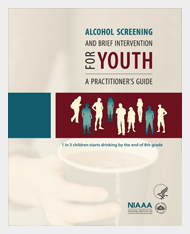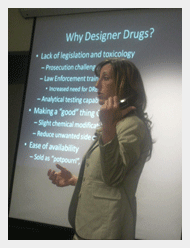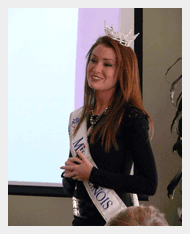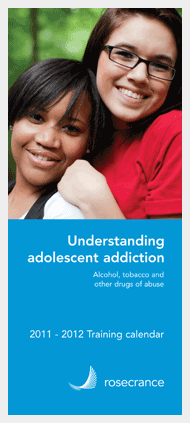
|
||
|
NOVEMBER 2011 ENEWSLETTER
|
||

|
||

|
||||
|
|

DOWNLOAD THE GUIDE (11MB):Click the image above to download "Alcohol Screening and Brief Intervention for Youth: A Practitioner's Guide." |
1 IN 3 KIDS BEGINS DRINKING BEFORE 9TH GRADE, SAYS NIAAAAgency releases free teen alcohol risk screening guide for healthcare professionals The National Institute on Alcohol Abuse and Alcoholism (NIAAA) has released "Alcohol Screening and Brief Intervention for Youth: A Practitioner's Guide" to help healthcare professionals identify children and teenagers ages 9 to 18 who are at risk for alcohol-related problems. The guide provides brief counseling and refers professionals to treatment resources. According to the report, 1 in 3 children starts drinking by the end of 8th grade - and of them, half report having been drunk. "It's not surprising," said Dr. Thomas Wright, chief medical officer at Rosecrance. "We've been following these trends for many years and the use of alcohol and other substances among younger kids definitely has been increasing. "I think screening for substance abuse issues in primary care settings is an important tool we have to help with the illness of addiction." Highlights for healthcare providers: The new screening tool can detect risk early: In contrast to other screens that focus on established alcohol problems, this early-detection tool aims to help professionals prevent alcohol-related problems in patients before they start or address them at an early stage. It's empirically based: The screening questions and risk scale, developed through primary survey research, are powerful predictors of current and future negative consequences of alcohol use. It's fast and versatile: The screen consists of just two questions, which can be incorporated easily into patient interviews or pre-visit screening tools across the care spectrum, from annual exams to urgent care. It's the first tool to include friends' drinking:The "friends" question helps identify patients at earlier stages of alcohol involvement and targets advice to include the important risk of friends' drinking. |
|||
|
|

"not for human consumption"Though marketed as "bath salts" and packaged with instructions advising users not to ingest the products, designer drugs are becoming popular among both teens and adults. Wisconsin forensic toxicologist Amy Miles stressed the dangers of consuming the products, as there is no reliable research on the long- or short-term effects of these new drugs. |
TOXICOLOGIST STRESSES DANGERS OF 'DESIGNER' DRUGSNo long-term report on effects of drugs yet available About a dozen local law enforcement officers joined more than 50 Rosecrance staff on Oct. 28 for a training at the Rosecrance Harrison Campus about the dangerous "designer drug" K-2/Spice, often sold as "bath salts." Presenter Amy Miles, a forensic toxicologist for the State of Wisconsin, stressed that there is no reliable research on the effects of these new drugs, which have become popular among teens and adults alike. The drug often looks like organic material resembling potpourri or marijuana. It has been treated with a synthetic drug of various chemical properties and strengths. The effects, while unpredictable, include seizures, hallucinations, euphoria, disorientation, increased heart rate and blood pressure, paranoia, poor perception of time and distance, irritability, restlessness, body tremors and aches, profuse sweating, violent behavior and combativeness. "People are taking them, and they are not really sure what the effects are," Miles said. The drug packages may be labeled "not for human consumption," Miles said, but those instructions are ignored as the synthetic drugs are baked into food products, smoked, snorted or injected. The drugs also may be converted to pill or liquid form. Ingredients in some of the early generation of the so-called bath salts were made illegal in both Wisconsin and Illinois. In response, Miles said, drug manufacturers have been busy altering the chemical structure of the illegal drugs to create loopholes that keep the products on the market. |
|||

RED RIBBON WEEK:Hannah Smith, Miss Illinois 2011, visited adolescent patients at Rosecrance Griffin Williamson Campus on Oct. 21, 2011, as part of Red Ribbon Week. |
MISS ILLINOIS VISITS ROSECRANCE AS PART OF RED RIBBON WEEKHannah Smith, Miss Illinois 2011, visited adolescent patients at Rosecrance Griffin Williamson Campus in October as part of Red Ribbon Week. Smith's message was simple: Character counts - even when no one is watching. She also spoke about the dangers of distracted driving, especially texting and driving among teenagers. Red Ribbon Week is the oldest and largest drug prevention campaign in the country. Red Ribbon Week generally takes place the last full week in October. Red Ribbon Week celebrates communities and individuals taking a stand for the hopes and dreams of children through a commitment to drug prevention, education and a personal commitment to living drug free lives. The goal of Red Ribbon Week is a drug-free America. Smith, originally from Huntley, won the 2011 Miss Illinois pageant this summer. In January, she will compete for the title of Miss America at the 2012 pageant in Las Vegas. |
|||
|
|
 |
TRAINING: UNDERSTANDING ADOLESCENT ADDICTIONThursday, Nov. 10, 2011 8:30 a.m. to 4:30 p.m. Rosecrance Griffin William Campus 1601 University Drive, Rockford, IL 61107 Participants will learn: Registration is free. Seven IAODAPCA CEUs and seven educational CPDUs offered with this training. Seating is limited. Click here to register online. | |||
|
|
ABOUT ROSECRANCERosecrance is a private not-for-profit organization offering behavioral health services for children, adolescents, adults and families. Rosecrance offers comprehensive addiction services for adolescents and adults, including prevention, intervention, detoxification, inpatient and outpatient treatment, experiential therapies, dual-diagnosis care and family education. Rosecrance also offers high-quality, efficient and effective outpatient mental health services for children, adults and families through a variety of programs. Rosecrance serves more than 13,000 families each year. |
|||||||
|
|||||||
Questions? Email Rosecrance Communications Director Judy Emerson |